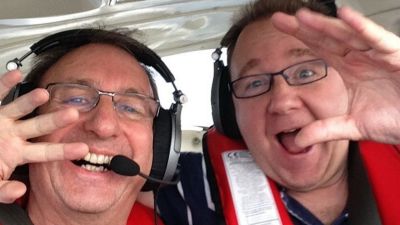Midlands pilots whose plane crashed in English Channel 'not qualified to fly in cloud'

A former mechanic from Birmingham and his co-pilot from Stratford whose plane lost contact with air traffic control over the English Channel were not qualified to fly in cloud air accident investigators have said.
Lee Rogers and Brian Statham, who had 20 years of flying experience between them, were traveling from Wellesbourne Mountford Airfield in Warwickshire to Le Touquet in France on April 2nd when the plane lost contact before crashing into the English Channel.
The French and English coastguard searched for more than two days for any sign of wreckage, bodies or clues to help and figure out what happened to the two pilots.
The Air Accidents Investigation Branch (AAIB) is currently carrying out an investigation into the crash.
The pair are said to have entered cloud over the channel and then contact was lost with them 20 nautical miles west of Le Touquet shortly before 9.20am. Warwickshire Police previously said the pair encountered ‘freak weather conditions’ over the channel, although accident investigators said ‘the cloud was forecast’ and indeed seen by the pilots en route.
The plane descended and then climbed with investigators believing the pilots may have been trying to avoid the cloud. At the last point of contact it turned and descended at a speed of more than 100 mph (10,000 feet per minute), where it is believed to have crashed into the channel.
The investigation by the AAIB on May 13 said, “It is not possible to know the pilots’ intentions but these changes in altitude might have been an attempt to avoid cloud. Once reaching 7,000 ft they were unable to climb any higher due to the controlled airspace above.
“Shortly after reaching 7,000 ft the radio transmission from the aircraft confirmed the aircraft had entered cloud. Neither occupant was qualified to fly in cloud. It is not known if they entered cloud inadvertently.
“The video recording from G-EGVA and the photographs from the other aircraft show the cloud was clearly defined and visible when several miles away. So, there should have been sufficient time to turn around if they were unable to route around the cloud."
It continued: "It is possible that the occupants’ previous experience of flying through cloud without incident encouraged them to try to fly through it on this occasion. It is not known exactly when the aircraft entered cloud.
“However, in the couple of minutes before the aircraft was lost from radar, the aircraft started to vary its heading and altitude before descending in a steepening right turn. The forecast severe turbulence and icing in cloud may have contributed to the departure from controlled flight.
The accident investigators said control of the aircraft was lost when it entered ‘highly active cumulus cloud, which had been forecast’.